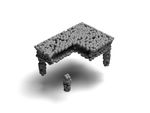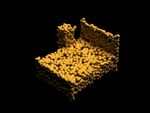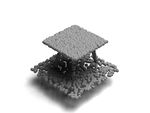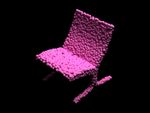ROBUSTPOINTSET: A DATASET FOR BENCHMARKING ROBUSTNESS OF POINT CLOUD CLASSIFIERS
←
→
Page content transcription
If your browser does not render page correctly, please read the page content below
Published as a conference paper at ICLR 2021
ROBUST P OINT S ET: A DATASET FOR B ENCHMARKING
ROBUSTNESS OF P OINT C LOUD C LASSIFIERS
Saeid Asgari Taghanaki & Jieliang Luo ∗
Autodesk AI Lab
Ran Zhang, Ye Wang & Pradeep Kumar Jayaraman
Autodesk Research
arXiv:2011.11572v5 [cs.CV] 16 Apr 2021
Krishna Murthy Jatavallabhula
Mila, Université de Montréal
A BSTRACT
The 3D deep learning community has seen significant strides in pointcloud pro-
cessing over the last few years. However, the datasets on which deep models
have been trained have largely remained the same. Most datasets comprise clean,
clutter-free pointclouds canonicalized for pose. Models trained on these datasets
fail in uninterpretible and unintuitive ways when presented with data that contains
transformations “unseen” at train time. While data augmentation enables models
to be robust to “previously seen” input transformations, 1) we show that this does
not work for unseen transformations during inference, and 2) data augmentation
makes it difficult to analyze a model’s inherent robustness to transformations. To
this end, we create a publicly available dataset for robustness analysis of point
cloud classification models (independent of data augmentation) to input transfor-
mations, called RobustPointSet. Our experiments indicate that despite all the
progress in the point cloud classification, there is no single architecture that consis-
tently performs better—several fail drastically—when evaluated on transformed
test sets. We also find that robustness to unseen transformations cannot be brought
about merely by extensive data augmentation. RobustPointSet can be accessed
through https://github.com/AutodeskAILab/RobustPointSet.
1 I NTRODUCTION
The performance of deep neural networks is often measured by their predictive behavior on a test
set. However, evaluating a model on an independently and identically distributed (i.i.d.) test set fails
to capture its underlying behavior even if the dataset is large enough Geirhos et al. (2020). Despite
the growing interest in robustness analysis of 2D deep models, less effort has been made in studying
the robustness of the models processing point clouds, i.e., sparse permutation-invariant point sets
representing 3D geometric data.
In practice, neural networks are often deployed to work with real-world pointcloud data that are
likely to be transformed in several ways. Point clouds obtained from 3D scans could be corrupted
by sensor noise, parts of the object may be missing due to occlusions, the object could be in a
different translated or rotated coordinate system, etc. (Figure 1). Although data augmentation might
help a model to perform well facing a previously seen input transformation, it does not improve
the performance of a model on handling different unseen transformations. Moreover, it hides the
real performance of a model processing transformed inputs e.g., rotation augmentation improves a
model’s performance on unseen rotated objects, however, this does not indicate whether the model
itself is rotation-invariant.
In order to take a step towards critical analysis and study the robustness of point cloud classification
models independent of data augmentation, we created a benchmark dataset called RobustPointSet
∗
Equal contribution; corresponding author: saeid.asgari.taghanaki@autodesk.com
1Published as a conference paper at ICLR 2021
(a) Original (b) Transformed
Figure 1: Pointcloud classification models trained on clean 3D datasets (a) often fail on data with
“unseen” transformations (b). We thoroughly analyze several pointcloud processing architectures
and observe that none of them consistently outperform the others. To further research in the robust-
ness of pointcloud classifiers, we created RobustPointSet, a publicly available dataset, and specified
evaluation protocols to quantify the robustness of models to “unseen” transformations during train-
ing.
which is a variant of ModelNet40 dataset Wu et al. (2015). In addition to the original training and
test sets of ModelNet40, our RobustPointSet consists of six different test sets each with a plausible
transformation.
In this paper, we make the following contributions:
1. We create a benchmark dataset for augmentation-independent robustness analysis of point
cloud classification models.
2. We empirically demonstrate that despite achieving high classification accuracy on aligned
and noise free objects, there is still a large space for improving point cloud classification
models to be able to operate well on challenging test samples.
3. We show that data-augmentation has a very small effect on unseen transformations.
2 R ELATED W ORK
Few robust methods exist for handling transformed point clouds during inference. Recently, Yan et
al. Yan et al. (2020) proposed an adaptive sampling scheme to compute non-local features to make
the model robust to noise. While this method takes a critical step towards robustness analysis, it
is mainly tailored to handle noise. Xiao et al Xiao & Wachs (2020) presented a descriptor that is
insensitive to pose and sparsity. However, it is not clear if their method generalizes to other unseen
transformations during inference.
There are a limited number of datasets that can be used to train point cloud classification methods.
A common dataset is ModelNet40 Wu et al. (2015) which contains 12,308 CAD models of 40 cate-
gories. ShapeNet Chang et al. (2015) is another large-scale dataset of 3D CAD shapes with approx-
imately 51,000 objects in 55 categories. However, in these datasets objects are aligned, complete,
and free from any background noise which often is not the case in practice. ScanObjectNN Uy et al.
(2019) is an alternative relatively small dataset with 2,902 samples collected from scanned indoor
scene data that are grouped into 15 classes. ScanObjectNN puts together objects from SceneNN Hua
et al. (2016) and ScanNet Dai et al. (2017) datasets to cover some of the real-world challenges such
as background noise and incomplete objects with the goal of analyzing the general performance of
point cloud methods in more challenging scenarios. However, as a mix of multiple transformations
might happen in both training and test sets of ScanObjectNN, it is impossible to study models’
behaviors on particular transformations separately.
3 ROBUST P OINT S ET
We present RobustPointSet, a dataset designed to evaluate and benchmark the robustness of point-
cloud classifiers to transformations “unseen” at train time. RobustPointSet is based on Model-
Net40 Wu et al. (2015), contains 12, 308 CAD models of 40 different categories. In addition to
original train and test sets of size 9, 840 and 2, 468, respectively found in ModelNet40, Robust-
PointSet contains 6 additional “transformed” versions of the original training and test sets. These
sets are used to train and evaluate models under two different strategies detailed in subsections 4.1
and 4.2. As shown in Figure 2, the transformations we applied in RobustPointSet include:
2Published as a conference paper at ICLR 2021
• Noise: We add random noise sampled from a normal distribution to each point.
• Missing part: We split each object to 8 axis-aligned chunks and randomly delete one.
• Occlusion: Given an object, we add a random wall and/or a random part from another
object to it. The random part is taken similar to ‘Missing part’ set, while walls are points
sampled from a plane added to the top, bottom, left, right, front, or back of the object.
• Sparse: We randomly set ∼ 93% of the 2048 points of each object to zero i.e., each object
has only 128 valid points in this set.
• Rotation: We apply a random rotation on an arbitrary axis to each object.
• Translation: Each object is translated by a 3D vector t sampled from the standard distri-
t
bution which is normalized as t = α × ( ktk ), where α = 0.1.
For all the transformations above, we ensure both training and test sets remain in the normalized
range of [−1, 1] along each axis by clipping.
Original Noise Missing part Occlusion Sparse Rotation
Figure 2: A few samples of the RobustPointSet dataset with different transformations.
4 BASELINE E XPERIMENTS
We designed two strategies to train and evaluate two groups of general and rotation-invariant mod-
els using our RobustPointSet dataset. For all the methods, we used the default hyper-parameters as
reported in their papers. To assess the extent to which a model is robust to different input transforma-
tions, we do not apply any data augmentation during training in any of the two strategies explained
in subsections 4.1 and 4.2. We encourage researchers to follow the same setup.
We consider 10 different point cloud baseline models under two main groups: PointNet Qi et al.
(2017a), PointNet++ Qi et al. (2017b) (both MSG and SSG), DGCNN Wang et al. (2019), Dense-
Point Liu et al. (2019a), PointCNN Li et al. (2018), PointMask Taghanaki et al. (2020), Point-
Conv Wu et al. (2019), and Relation-Shape-CNN Liu et al. (2019b) as general approaches, while
SPHnet Poulenard et al. (2019) and PRIN You et al. (2018) as rotation invariant methods.
4.1 T RAINING - DOMAIN VALIDATION
In this setup, we trained each method with the original training set and selected the best performing
checkpoint on the original validation set for each method. We then tested the models with selected
checkpoints on the six transformed unseen test sets. This experiment shows the vulnerability of
the models trained on original data to unseen input transformations. As reported in Table 1, general
classification methods mostly fail on the Noise and Sparse test sets. Simple rigid transformations
like translation and rotation are sufficient to degrade test set classification accuracy by up to 10%
and 80%, respectively. Methods that leverage local information suffer greatly, with reduction of up
to 85% in accuracy when the notion of neighborhood is changed in test time through the addition
of noise or introduction of sparsity. Among general approaches, PointNet outperforms others with
average accuracy of 61.97%. Although rotation invariant methods such as SPHnet and PRIN show
robustness to rotations and translation, they fail on other transformations with high error rates.
4.2 L EAVE - ONE - OUT VALIDATION
This experiment shows whether data augmentation helps in generalizing to an unseen transforma-
tion. Here, we trained the models with six training sets and tested on the test set of the held out set.
3Published as a conference paper at ICLR 2021
Table 1: Training-domain validation results on our RobustPointSet test sets. The Noise column
for example shows the result of training on the Original train set and testing with the Noise test
set. RotInv refers to rotation-invariant models.
Type Method Original Noise Translation MissingPart Sparse Rotation Occlusion Avg.
PointNet 89.06 74.72 79.66 81.52 60.53 8.83 39.47 61.97
PointNet++ (M) 91.27 5.73 91.31 53.69 6.65 13.02 64.18 46.55
PointNet++ (S) 91.47 14.90 91.07 50.24 8.85 12.70 70.23 48.49
General
DGCNN 92.52 57.56 91.99 85.40 9.34 13.43 78.72 61.28
PointMask 88.53 73.14 78.20 81.48 58.23 8.02 39.18 60.97
DensePoint 90.96 53.28 90.72 84.49 15.52 12.76 67.67 59.40
PointCNN 87.66 45.55 82.85 77.60 4.01 11.50 59.50 52.67
PointConv 91.15 20.71 90.99 84.09 8.65 12.38 45.83 50.54
R-ShapeCNN 91.77 48.06 91.29 85.98 23.18 11.51 75.61 61.06
79.18
RInv
SPHnet 79.18 7.22 4.22 1.26 79.18 34.33 40.65
PRIN 73.66 30.19 41.21 44.17 4.17 68.56 31.56 41.93
For example, consider three sets {A{tr,ts} , B{tr,ts} , C{tr,ts} } where tr and ts refer to training and
testing sets, respectively. we first train a model using {Atr , Btr } and test on Cts . Next, we train
with {Atr , Ctr } and test on Bts . Finally, we train with {Btr , Ctr } and test on Ats . This experiments
shows whether different transformations help to generalize to an unseen transformation.
Table 2: Leave-one-out validation strategy classification results on our RobustPointSet test sets.
For example, the Noise column shows the result of training on {Original, Translation,
Missing part, Sparse, Rotation, Occlusion} train sets and testing with the
Noise test set. RotInv refers to rotation-invariant models.
Type Method Original Noise Translation MissingPart Sparse Rotation Occlusion Avg.
PointNet 88.35 72.61 81.53 82.87 69.28 9.42 35.96 62.86
PointNet++ (M) 91.55 50.92 91.43 77.16 16.19 12.26 70.39 58.56
PointNet++ (S) 91.76 49.33 91.10 78.36 16.72 11.27 68.33 58.12
General
DGCNN 92.38 66.95 91.17 85.40 6.49 14.03 68.79 60.74
PointMask 88.03 73.95 80.80 82.83 63.64 8.97 36.69 62.13
DensePoint 91.00 42.38 90.64 85.70 20.66 8.55 47.89 55.26
PointCNN 88.91 73.10 87.46 82.06 7.18 13.95 52.66 57.90
PointConv 91.07 66.19 91.51 84.01 19.63 11.62 44.07 58.30
R-Shape-CNN 90.52 36.95 91.33 85.82 24.59 8.23 60.09 56.79
78.86
RInv
SPHnet 79.30 8.24 76.02 17.94 6.33 35.96 43.23
PRIN 76.54 55.35 56.36 59.20 4.05 73.30 36.91 51.67
We observe from the results in Table 2 that minor improvements of upto 10% on average are obtained
on a few methods, while others remain relatively unaffected. The improvement could be attributed
to the use of different transformations during training, which forces the model to choose a robust
set of features to make predictions. However, it is clear that none of the methods are close to their
accuracy on the “Original” test set.
5 C ONCLUSION
We have presented RobustPointSet, a dataset for studying the robustness of point cloud-based neural
networks. We benchmarked 10 state-of-the-art models and showed that none of the models, partic-
ularly the ones that exploit local neighborhood information, do well on transformed test sets. Our
results show that while PointNet Qi et al. (2017a) and DGCNN Wang et al. (2019) perform well
on average, there is no single approach that consistently performs better than the others across a
range of data transformations. This strongly highlights the need to consider robustness as a metric
when evaluating models. We hope our dataset will facilitate future research on robustness analy-
sis for point cloud classification models. While software frameworks for pointcloud processing are
increasingly being developed Jatavallabhula et al. (2019); Chaton et al. (2020); Ravi et al. (2020),
4Published as a conference paper at ICLR 2021
the datasets used for training pointcloud classifiers have largely remaind the same. RobustPointSet
addresses this gap, and we experimentally show the need for developing models robust to data trans-
formations – particularly those unseen at train time. In future, we are interested in exploring the
design of robust pointcloud classifiers that mitigate the effects introduced by bias in the datasets
used to train them.
R EFERENCES
Angel X Chang, Thomas Funkhouser, Leonidas Guibas, Pat Hanrahan, Qixing Huang, Zimo Li,
Silvio Savarese, Manolis Savva, Shuran Song, Hao Su, et al. Shapenet: An information-rich 3d
model repository. arXiv preprint arXiv:1512.03012, 2015.
Thomas Chaton, Chaulet Nicolas, Sofiane Horache, and Loic Landrieu. Torch-points3d: A modular
multi-task frameworkfor reproducible deep learning on 3d point clouds. In 2020 International
Conference on 3D Vision (3DV), 2020.
Angela Dai, Angel X Chang, Manolis Savva, Maciej Halber, Thomas Funkhouser, and Matthias
Nießner. Scannet: Richly-annotated 3d reconstructions of indoor scenes. In Proceedings of the
IEEE Conference on Computer Vision and Pattern Recognition, pp. 5828–5839, 2017.
Robert Geirhos, Jörn-Henrik Jacobsen, Claudio Michaelis, Richard Zemel, Wieland Brendel,
Matthias Bethge, and Felix A Wichmann. Shortcut learning in deep neural networks. arXiv
preprint arXiv:2004.07780, 2020.
Binh-Son Hua, Quang-Hieu Pham, Duc Thanh Nguyen, Minh-Khoi Tran, Lap-Fai Yu, and Sai-
Kit Yeung. Scenenn: A scene meshes dataset with annotations. In 2016 Fourth International
Conference on 3D Vision (3DV), pp. 92–101. IEEE, 2016.
Krishna Murthy Jatavallabhula, Edward Smith, Jean-Francois Lafleche, Clement Fuji Tsang, Artem
Rozantsev, Wenzheng Chen, Tommy Xiang, Rev Lebaredian, and Sanja Fidler. Kaolin: A pytorch
library for accelerating 3d deep learning research. arXiv:1911.05063, 2019.
Yangyan Li, Rui Bu, Mingchao Sun, Wei Wu, Xinhan Di, and Baoquan Chen. Pointcnn: Convolu-
tion on x-transformed points. In Advances in neural information processing systems, pp. 820–830,
2018.
Yongcheng Liu, Bin Fan, Gaofeng Meng, Jiwen Lu, Shiming Xiang, and Chunhong Pan. Dense-
point: Learning densely contextual representation for efficient point cloud processing. In Pro-
ceedings of the IEEE International Conference on Computer Vision, pp. 5239–5248, 2019a.
Yongcheng Liu, Bin Fan, Shiming Xiang, and Chunhong Pan. Relation-shape convolutional neural
network for point cloud analysis. In Proceedings of the IEEE Conference on Computer Vision
and Pattern Recognition, pp. 8895–8904, 2019b.
Adrien Poulenard, Marie-Julie Rakotosaona, Yann Ponty, and Maks Ovsjanikov. Effective rotation-
invariant point cnn with spherical harmonics kernels. In 2019 International Conference on 3D
Vision (3DV), pp. 47–56. IEEE, 2019.
Charles R Qi, Hao Su, Kaichun Mo, and Leonidas J Guibas. Pointnet: Deep learning on point sets
for 3d classification and segmentation. In Proceedings of the IEEE conference on computer vision
and pattern recognition, pp. 652–660, 2017a.
Charles Ruizhongtai Qi, Li Yi, Hao Su, and Leonidas J Guibas. Pointnet++: Deep hierarchical
feature learning on point sets in a metric space. In Advances in neural information processing
systems, pp. 5099–5108, 2017b.
Nikhila Ravi, Jeremy Reizenstein, David Novotny, Taylor Gordon, Wan-Yen Lo, Justin Johnson,
and Georgia Gkioxari. Accelerating 3d deep learning with pytorch3d. arXiv:2007.08501, 2020.
Saeid Asgari Taghanaki, Kaveh Hassani, Pradeep Kumar Jayaraman, Amir Hosein Khasahmadi, and
Tonya Custis. Pointmask: Towards interpretable and bias-resilient point cloud processing. arXiv
preprint arXiv:2007.04525, 2020.
5Published as a conference paper at ICLR 2021
Mikaela Angelina Uy, Quang-Hieu Pham, Binh-Son Hua, Thanh Nguyen, and Sai-Kit Yeung. Revis-
iting point cloud classification: A new benchmark dataset and classification model on real-world
data. In Proceedings of the IEEE International Conference on Computer Vision, pp. 1588–1597,
2019.
Yue Wang, Yongbin Sun, Ziwei Liu, Sanjay E Sarma, Michael M Bronstein, and Justin M Solomon.
Dynamic graph cnn for learning on point clouds. Acm Transactions On Graphics (tog), 38(5):
1–12, 2019.
Wenxuan Wu, Zhongang Qi, and Li Fuxin. Pointconv: Deep convolutional networks on 3d point
clouds. In Proceedings of the IEEE Conference on Computer Vision and Pattern Recognition, pp.
9621–9630, 2019.
Zhirong Wu, Shuran Song, Aditya Khosla, Fisher Yu, Linguang Zhang, Xiaoou Tang, and Jianxiong
Xiao. 3d shapenets: A deep representation for volumetric shapes. In Proceedings of the IEEE
conference on computer vision and pattern recognition, pp. 1912–1920, 2015.
Chenxi Xiao and J. Wachs. Triangle-net: Towards robustness in point cloud classification. ArXiv,
abs/2003.00856, 2020.
Xu Yan, Chaoda Zheng, Zhen Li, Sheng Wang, and Shuguang Cui. Pointasnl: Robust point clouds
processing using nonlocal neural networks with adaptive sampling. 2020.
Yang You, Yujing Lou, Qi Liu, Yu-Wing Tai, Weiming Wang, Lizhuang Ma, and Cewu Lu. Prin:
Pointwise rotation-invariant network. arXiv preprint arXiv:1811.09361, 2018.
6You can also read



























































